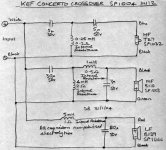I thought it might be interesting to look at Butterworth filters in general, since evidently no-one here really has a clue how they work! 😀
I set up a shallow Bud Fried-type series filter with some resemblance to his designs with KEF drivers on transmission lines. I then converted it to third order 18dB/octave BW3.
I suppose you could use Bud Fried's lovely original shallow series crossover, which has good impulse response and fine phase alignment and flat impedance, or my slightly deeper slope Butterworth third order. Matter of taste really. Higher slopes mean less distortion with complex program material.
Here's the mark of a good odd order Butterworth. Flip the tweeter polarity and it makes hardly a scrap of difference to anything you measure. In fact my definition of Butterworth is odd-order. Different from 12dB/octave LR2 and 24db/octave LR4. There is actually no +3dB hump because of the 90 degree phase relation.
FWIW, the Fried Model H is clearly a Butterworth top end. Bit of that KEF 0.47uF acoustic butterworth too. Credit to planet10 aka Dave @t-linespeakers.org. for the Fried image.
I set up a shallow Bud Fried-type series filter with some resemblance to his designs with KEF drivers on transmission lines. I then converted it to third order 18dB/octave BW3.
I suppose you could use Bud Fried's lovely original shallow series crossover, which has good impulse response and fine phase alignment and flat impedance, or my slightly deeper slope Butterworth third order. Matter of taste really. Higher slopes mean less distortion with complex program material.
Here's the mark of a good odd order Butterworth. Flip the tweeter polarity and it makes hardly a scrap of difference to anything you measure. In fact my definition of Butterworth is odd-order. Different from 12dB/octave LR2 and 24db/octave LR4. There is actually no +3dB hump because of the 90 degree phase relation.
FWIW, the Fried Model H is clearly a Butterworth top end. Bit of that KEF 0.47uF acoustic butterworth too. Credit to planet10 aka Dave @t-linespeakers.org. for the Fried image.
Attachments
-
 Fried Model H Crossover Parallel.JPG46 KB · Views: 330
Fried Model H Crossover Parallel.JPG46 KB · Views: 330 -
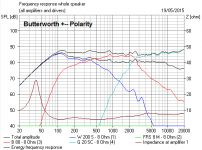 S7 1 Butterworth +-- polarity Freq Response.PNG15.7 KB · Views: 1,071
S7 1 Butterworth +-- polarity Freq Response.PNG15.7 KB · Views: 1,071 -
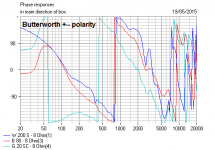 S7 2 Butterworth +-- polarity phase.PNG15.5 KB · Views: 1,066
S7 2 Butterworth +-- polarity phase.PNG15.5 KB · Views: 1,066 -
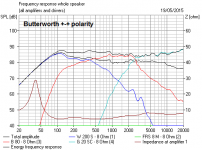 S7 3 Butterworth +-+ polarity Freq Response.PNG15.6 KB · Views: 285
S7 3 Butterworth +-+ polarity Freq Response.PNG15.6 KB · Views: 285 -
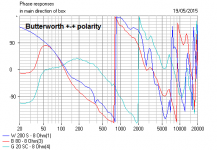 S7 4 Butterworth +-+ polarity Phase.PNG14.7 KB · Views: 284
S7 4 Butterworth +-+ polarity Phase.PNG14.7 KB · Views: 284 -
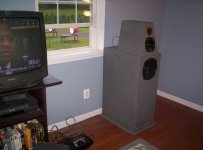 speakers_time_aligned_speakerman19422.jpg71.6 KB · Views: 176
speakers_time_aligned_speakerman19422.jpg71.6 KB · Views: 176
No one has touched on the very nature of the question "what IS a Butterworth filter?". There certainly has been much handwaving about how to construct one, etc. But what's in that name, ol "Butterworth"?
That's the name of the guy who came up with the filter type that has the characteristic that its response stays flat to a frequency as close to the "corner frequency" as possible before the response turns down. That's it!
But I have to laugh when I hear people trying to use a Butterworth filter with their passive crossover loudspeaker crossover. A Butterworth filter, like all the other "famous name" filters, is defined with a resistive loads. A loudspeaker driver is reactive, so what you really have is a filter network that rolls off the power to the driver in some fashion and, depending on the components used and the layout, that rolloff in power can reach about 6dB per octave per order, more or less.
When you are doing crossover design, the important things to think about are (A) the order of the crossover as this will dictate the filter network topology, and (B) the relative phase angle between the drivers at frequencies where two or more are producing sound to the extent that the sound waves from each can interfere with each other. Don't worry about the fancy names!
That's the name of the guy who came up with the filter type that has the characteristic that its response stays flat to a frequency as close to the "corner frequency" as possible before the response turns down. That's it!
But I have to laugh when I hear people trying to use a Butterworth filter with their passive crossover loudspeaker crossover. A Butterworth filter, like all the other "famous name" filters, is defined with a resistive loads. A loudspeaker driver is reactive, so what you really have is a filter network that rolls off the power to the driver in some fashion and, depending on the components used and the layout, that rolloff in power can reach about 6dB per octave per order, more or less.
When you are doing crossover design, the important things to think about are (A) the order of the crossover as this will dictate the filter network topology, and (B) the relative phase angle between the drivers at frequencies where two or more are producing sound to the extent that the sound waves from each can interfere with each other. Don't worry about the fancy names!
Would I be correct in suggesting that combining capacitors in parallel gives a total capacitance of their sum - i.e. 50uF + 50uF + 40uF = 140uF?
This would give me an approximate cost from Falcon Acoustics of about £40 for the 12 Alcap 2% tolerance 50 Volt Capacitors to achieve 140 uF and the four 2% tolerance Ferrite Core Inductors at 18 mH. Would one actually need exactly 140 uF Capacitors or would single 150 uF components suffice - and save £10 and some soldering?
I calculate that these components would allow the construction of a pair of 2nd Order Butterworth filters rolling off by 12dB per octave at 100 Hz.
This would give me an approximate cost from Falcon Acoustics of about £40 for the 12 Alcap 2% tolerance 50 Volt Capacitors to achieve 140 uF and the four 2% tolerance Ferrite Core Inductors at 18 mH. Would one actually need exactly 140 uF Capacitors or would single 150 uF components suffice - and save £10 and some soldering?
I calculate that these components would allow the construction of a pair of 2nd Order Butterworth filters rolling off by 12dB per octave at 100 Hz.
Hi,
Sadly S7 is using the wrong drivers to illustrate his points.
(And its not like it doesn't matter, it very much does.)
I'll repeat again passive sub x/o's are a nightmare,
and are best avoided by the sensible. You should
ignore idiotic calculators and suggested values.
An active sub is the way to go.
rgds, sreten.
Sadly S7 is using the wrong drivers to illustrate his points.
(And its not like it doesn't matter, it very much does.)
I'll repeat again passive sub x/o's are a nightmare,
and are best avoided by the sensible. You should
ignore idiotic calculators and suggested values.
An active sub is the way to go.
rgds, sreten.
For the price of large-value inductors you can buy a decent plate-amp, and interaction between a passive cross-over and driver when you desire a low corner-frequency tends to make a pile of doodoo
I have done both, repeatedly, and yes, you may well be wrong ;^).I take your point about the potential benefit of the miniDSP route. However, I suspect that experimenting with / utilising one may not be significantly less challenging than assembling a passive crossover for drivers with known parameters? I haven't done either yet so I may well be wrong.
What takes hours of experimentation with hundreds of dollars worth of passive components (before one begins to solder) can be done in minutes with DSP based crossovers. In either case, measurement tools are needed to determine the acoustical output is what you want it to be.
Ditto above. I don't use mini DSP but my approach is similar. DSP crossovers allow for very rapid prototyping and verification by ear and measures. You can then proceed to other types of crossovers if you wish.
Fair enough, I'm convinced. I'll just buy a second-hand active sub-woofer off eBay and put the B200s on eBay.
Many thanks for all your suggestions.
Many thanks for all your suggestions.
Aw, that's a bit sad! I wonder if you made it more difficult than it is with this Bud Fried Coffin design?Fair enough, I'm convinced. I'll just buy a second-hand active sub-woofer off eBay and put the B200s on eBay.
Many thanks for all your suggestions.
I do have the series circuit for it, but am sworn to secrecy by speakerman19422! And it is extremely neat, but actually is more of an LR2 design than a butterworth. 😱
I don't see why you couldn't build a KEF Concerto with a a B200 rather than a B139. The B200 will presumably be less loud, so you'll need to take down the mid and treble levels. This is not hard. Bass cabinet to suit the B200 SP1022, which is known territory.
Attachments
Last edited:
Hey survivor,
sreten is right, designing the bass of speakers is more headache than crossing the midpoint of midrange-tweeter, once you get that right the bass usually is weak so you need to implement a big inductor to create an 'artificial' hump for the bass + combination of vented design. Then nothing works anymore...
I like the Gibraltar G-1, two of them ....'s great 🙂
sreten is right, designing the bass of speakers is more headache than crossing the midpoint of midrange-tweeter, once you get that right the bass usually is weak so you need to implement a big inductor to create an 'artificial' hump for the bass + combination of vented design. Then nothing works anymore...
I like the Gibraltar G-1, two of them ....'s great 🙂
- Status
- Not open for further replies.
- Home
- Loudspeakers
- Multi-Way
- Can someone please explain Butterworth crossovers . . . in layman's terms?
 Seemed like this was more of a multi-way sort of discussion so I have moved it.
Seemed like this was more of a multi-way sort of discussion so I have moved it.